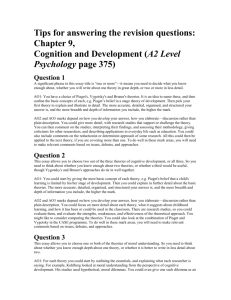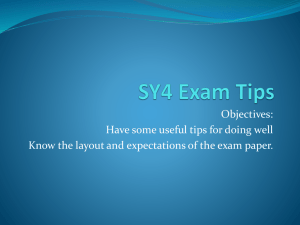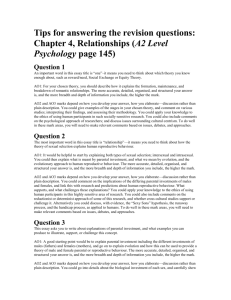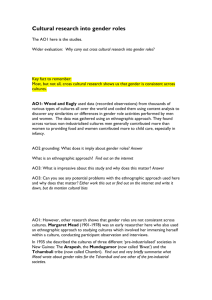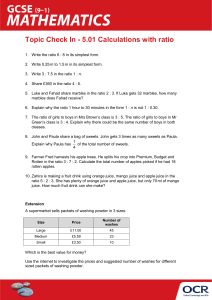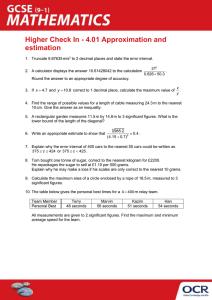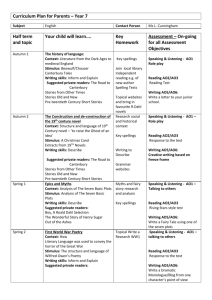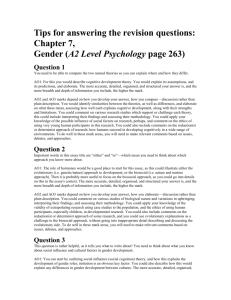Foundation Check In - 4.01 Approximation and estimation
advertisement
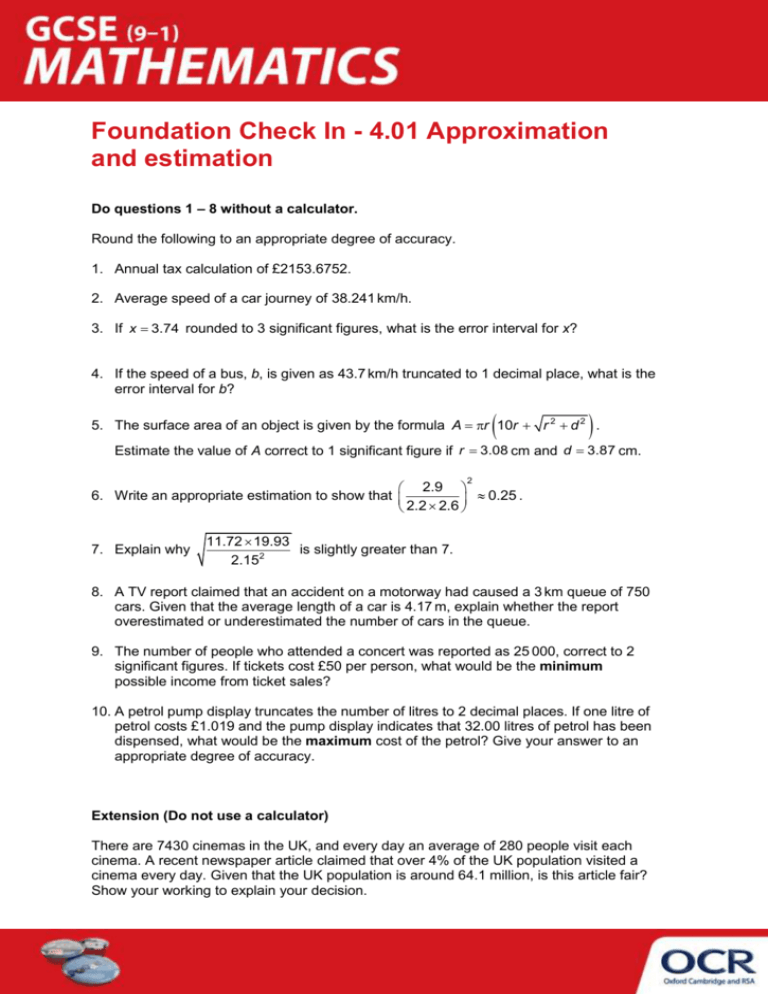
Foundation Check In - 4.01 Approximation and estimation Do questions 1 – 8 without a calculator. Round the following to an appropriate degree of accuracy. 1. Annual tax calculation of £2153.6752. 2. Average speed of a car journey of 38.241 km/h. 3. If x 3.74 rounded to 3 significant figures, what is the error interval for x? 4. If the speed of a bus, b, is given as 43.7 km/h truncated to 1 decimal place, what is the error interval for b? 5. The surface area of an object is given by the formula A r 10r r 2 d 2 . Estimate the value of A correct to 1 significant figure if r 3.08 cm and d 3.87 cm. 2 2.9 6. Write an appropriate estimation to show that 0.25 . 2.2 2.6 7. Explain why 11.72 19.93 is slightly greater than 7. 2.152 8. A TV report claimed that an accident on a motorway had caused a 3 km queue of 750 cars. Given that the average length of a car is 4.17 m, explain whether the report overestimated or underestimated the number of cars in the queue. 9. The number of people who attended a concert was reported as 25 000, correct to 2 significant figures. If tickets cost £50 per person, what would be the minimum possible income from ticket sales? 10. A petrol pump display truncates the number of litres to 2 decimal places. If one litre of petrol costs £1.019 and the pump display indicates that 32.00 litres of petrol has been dispensed, what would be the maximum cost of the petrol? Give your answer to an appropriate degree of accuracy. Extension (Do not use a calculator) There are 7430 cinemas in the UK, and every day an average of 280 people visit each cinema. A recent newspaper article claimed that over 4% of the UK population visited a cinema every day. Given that the UK population is around 64.1 million, is this article fair? Show your working to explain your decision. Answers 1. £2154 to the nearest pound (£2153.68 to the nearest penny) 2. 38 km/h (accept 40 km/h) 3. 3.735 x 3.745 4. 43.7 b 43.8 5. 315 cm2 2 2 1 3 1 6. 4 23 2 7. 10 20 200 50 and 2 4 2 50 49 8. 3000 4 750 cars, but the average car length is greater than 4 m so the number of cars has been overestimated. In addition, there will be gaps between the cars so there will be fewer cars in the queue. 9. 24500 £50 £1225000 10. £32.62 Extension Cinema visits per day 7000 300 2100000 4% of the UK population 60000000 100 4 2400000 The article is not fair. The percentage of the population visiting cinemas every day has been overestimated. We’d like to know your view on the resources we produce. By clicking on ‘Like’ or ‘Dislike’ you can help us to ensure that our resources work for you. When the email template pops up please add additional comments if you wish and then just click ‘Send’. Thank you. If you do not currently offer this OCR qualification but would like to do so, please complete the Expression of Interest Form which can be found here: www.ocr.org.uk/expression-of-interest OCR Resources: the small print OCR’s resources are provided to support the teaching of OCR specifications, but in no way constitute an endorsed teaching method that is required by the Board, and the decision to use them lies with the individual teacher. Whilst every effort is made to ensure the accuracy of the content, OCR cannot be held responsible for any errors or omissions within these resources. We update our resources on a regular basis, so please check the OCR website to ensure you have the most up to date version. © OCR 2016 - This resource may be freely copied and distributed, as long as the OCR logo and this message remain intact and OCR is acknowledged as the originator of this work. OCR acknowledges the use of the following content: Maths and English icons: Air0ne/Shutterstock.com Assessment Objective Qu. Topic R A G Assessment Objective Qu. Topic AO1 1 Round to an appropriate degree of accuracy AO1 1 Round to an appropriate degree of accuracy AO1 2 Round to an appropriate degree of accuracy AO1 2 Round to an appropriate degree of accuracy AO1 3 AO1 3 AO1 4 AO1 4 AO1 5 Substitute appropriate approximate values into a formula AO1 5 Substitute appropriate approximate values into a formula AO2 6 Use appropriate approximations to check an answer AO2 6 Use appropriate approximations to check an answer AO2 7 AO2 8 Use inequality notation to write the error interval of a rounded value Use inequality notation to write the error interval of a truncated value Use appropriate approximations to make an estimation of a complex calculation Use appropriate approximations to estimate an answer to a problem AO2 8 AO3 9 Use limits of accuracy to solve a problem in context AO3 9 Use limits of accuracy to solve a problem in context AO3 10 Use limits of accuracy to solve a problem in context, rounding the answer to an appropriate degree of accuracy AO3 10 Use limits of accuracy to solve a problem in context, rounding the answer to an appropriate degree of accuracy Assessment Qu. Assessment Qu. Topic R A G Objective AO1 1 Round to an appropriate degree of accuracy AO1 1 Round to an appropriate degree of accuracy AO1 2 Round to an appropriate degree of accuracy AO1 2 Round to an appropriate degree of accuracy AO1 3 AO1 3 AO1 4 AO1 4 AO1 5 Substitute appropriate approximate values into a formula AO1 5 Substitute appropriate approximate values into a formula AO2 6 Use appropriate approximations to check an answer AO2 6 Use appropriate approximations to check an answer AO2 7 AO2 7 AO2 8 AO2 8 AO3 9 Use limits of accuracy to solve a problem in context AO3 9 Use limits of accuracy to solve a problem in context 10 Use limits of accuracy to solve a problem in context, rounding the answer to an appropriate degree of accuracy AO3 10 Use limits of accuracy to solve a problem in context, rounding the answer to an appropriate degree of accuracy AO3 Use inequality notation to write the error interval of a rounded value Use inequality notation to write the error interval of a truncated value Use appropriate approximations to make an estimation of a complex calculation Use appropriate approximations to estimate an answer to a problem G R A G Use appropriate approximations to make an estimation of a complex calculation Use appropriate approximations to estimate an answer to a problem 7 Topic A Use inequality notation to write the error interval of a rounded value Use inequality notation to write the error interval of a truncated value AO2 Objective R Use inequality notation to write the error interval of a rounded value Use inequality notation to write the error interval of a truncated value Use appropriate approximations to make an estimation of a complex calculation Use appropriate approximations to estimate an answer to a problem

